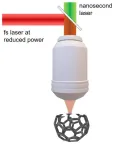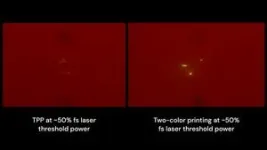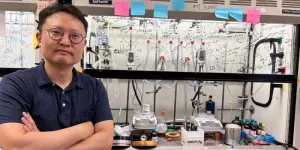(Press-News.org) WASHINGTON — Researchers have developed a new two-photon polymerization technique that uses two lasers to 3D print complex high-resolution structures. The advance could make this 3D printing process less expensive, helping it find wider use in a variety of applications.
Two-photon polymerization is an advanced additive manufacturing technique that traditionally uses femtosecond lasers to polymerize materials in a precise, 3D manner. Although this process works well for making high-resolution microstructures, it isn’t widely used in manufacturing because femtosecond lasers are expensive and increase the cost of printing parts.
“We combined a relatively low-cost laser emitting visible light with a femtosecond laser emitting infrared pulses to reduce the power requirement of the femtosecond laser,” said research team leader Xianfan Xu from Purdue University. “In this way, with a given femtosecond laser power, the printing throughput can be increased, leading to a lower cost for printing individual parts.”
In the Optica Publishing Group journal Optics Express, the researchers show that the two-laser approach reduces the femtosecond laser 3D printing power needed by as much as 50% compared to using a femtosecond laser alone.
“3D printing with high resolution has many applications, including 3D electronics devices, micro-robots for the biomedical field and 3D structures or scaffolds for tissue engineering,” said Xu. “Our novel, 3D printing approach can be readily implemented in many existing femtosecond laser 3D printing systems.”
Finding the right laser balance
The new work is part of the research team’s effort to continuously improve the printing speed and reduce the printing cost for two-photon polymerization, which uses the phenomenon of two-photo absorption to precisely cure, or solidify, a photosensitive material.
“In a conventional two-photon polymerization printing process, the femtosecond laser is first used to initiate a photochemical process that reduces the inhibition species in the material before printing starts,” said Xu. “We used a low-cost laser for this purpose instead.”
The new approach combines single-photon absorption from a 532 nm nanosecond laser with two-photon absorption from an 800-nm femtosecond laser. For this to work, the researchers had to find the right balance between the printing and inhibition caused by the two lasers. They did this by creating a new mathematical model to help them understand the photochemical processes involved and to compute the combined effect of two-photon and single-photon excitation processes. They also used the model to identify the dominant processes controlling how much the femtosecond laser’s power could be reduced while still achieving desirable printing results.
Printing detailed structures
After finetuning the new approach, they used it to print various 2D and 3D structures using reduced femtosecond laser power. These included detailed woodpiles measuring just 25 × 25 × 10 μm as well as a micron-scale buckyball, chiral structure and trefoil knot. Experimental results showed that the new method reduced the power required from the femtosecond laser by up to 80 percent for 2D structures and up to around 50 percent for 3D structures.
“This new printing approach could impact manufacturing technologies, influencing the development of devices across consumer electronics and healthcare sectors both now and in the future,” said Xu. The researchers are now working to further improve the printing speed and reduce the cost of 3D printing.
Paper: A. I. Akash, J. E. Johnson, F. C. Arentz, X. Xu, “Two-color 3D printing for reduction in femtosecond laser printing power,” Opt. Express, Vol. 32, Issue 15, pp. 25892-25905 (2024).
DOI: doi.org/10.1364/OE.525826
About Optica Publishing Group
Optica Publishing Group is a division of the society, Optica, Advancing Optics and Photonics Worldwide. It publishes the largest collection of peer-reviewed and most-cited content in optics and photonics, including 18 prestigious journals, the society’s flagship member magazine, and papers and videos from more than 835 conferences. With over 400,000 journal articles, conference papers and videos to search, discover and access, our publications portfolio represents the full range of research in the field from around the globe.
About Optics Express
Optics Express reports on scientific and technology innovations in all aspects of optics and photonics. The bi-weekly journal provides rapid publication of original, peer-reviewed papers. It is published by Optica Publishing Group and led by Editor-in-Chief James Leger of the University of Minnesota, USA. Optics Express is an open-access journal and is available at no cost to readers online. For more information, visit Optics Express.
END
Precise and less expensive 3D printing of complex, high-resolution structures
Researchers use two lasers for two-photon polymerization, increasing practicality of this 3D printing approach for consumer electronics, biomedical applications and more
2024-07-02
ELSE PRESS RELEASES FROM THIS DATE:
AGS member, George Kuchel, appointed to serve on ACIP
2024-07-02
The American Geriatrics Society extends its warmest congratulations to ADGAP President George Kuchel, MD, CM, FRCP on his appointment as a member expert of the Advisory Committee on Immunization Practices (ACIP). ACIP develops recommendations on the safe use of vaccines in the United States.
Dr. Kuchel, who became President of the Association of Directors of Geriatrics Academic Programs in spring 2024, is Director of both the UConn Center on Aging and the Claude D Pepper Older Americans Independence Center at the University of Connecticut. He has significant expertise and knowledge in vaccines and immunology, particularly in older adults, including performing ...
Researchers awarded Department of Defense grant to study the role of gut microbiomes to improve outcomes in dystonia
2024-07-02
Mohammad Moshahid Khan, PhD, principal investigator and associate professor in the Department of Neurology in the College of Medicine at the University of Tennessee Health Science Center, was recently awarded a $308,000 grant from the Department of Defense for a study that will investigate the role of the gut microbiome in dystonia, a movement disorder of abnormal postures and involuntary twisting or repetitive movements, to improve neurobehavioral outcomes. Jianfeng Xiao, MD, PhD, associate professor in the Department of Neurology, is the co-investigator of the study.
Although ...
Advancing toward a preventative HIV vaccine
2024-07-02
LA JOLLA, CA and NEW YORK, NY—A major challenge in developing a vaccine for HIV is that the virus mutates fast—very fast. Although a person initially becomes infected with one or a few HIV strains, the virus replicates and mutates quickly, resulting in a “swarm” of viral strains existing in a single body. But scientists at Scripps Research; IAVI; the Ragon Institute of Mass General, MIT, and Harvard; La Jolla Institute for Immunology; and additional institutions have conducted a series of preclinical ...
A Global Heat Early Warning system is now essential, and requires planning in four key areas to overcome barriers and enable successful implementation, per new review
2024-07-02
A Global Heat Early Warning system is now essential, and requires planning in four key areas to overcome barriers and enable successful implementation, per new review.
####
Article URL: https://journals.plos.org/climate/article?id=10.1371/journal.pclm.0000437
Article Title: Preventing heat-related deaths: The urgent need for a global early warning system for heat
Author Countries: Austria, Denmark, Sweden, Switzerland, US
Funding: CB,IMO, CG and JT are funded by Horizon Europe through the HIGH horizon project funded by the European Union’s Horizon Europe Programme (grant number 101057843). IMO and CG are also ...
An alternative way to manipulate quantum states
2024-07-02
Electrons have an intrinsic angular momentum, the so-called spin, which means that they can align themselves along a magnetic field, much like a compass needle. In addition to the electric charge of electrons, which determines their behaviour in electronic circuits, their spin is increasingly used for storing and processing data. Already now, one can buy MRAM memory elements (magnetic random access memories), in which information is stored in very small but still classical magnets – that is, ...
Study reveals new factor associated with the risk of severe COVID-19 in people with obesity
2024-07-02
Already at the beginning of the COVID-19 pandemic, a group of Brazilian researchers pioneered in showing why SARS-CoV-2 infection tends to be more severe in diabetic patients. Now, the same team based at the Institute of Biology of the State University of Campinas (IB-UNICAMP) has discovered one of the reasons why obese people who do not have diabetes or even insulin resistance also have an increased risk of developing the severe form of the disease.
“New experiments show that the molecular mechanisms are quite different in the two cases,” Pedro Moraes-Vieira, a professor at IB-UNICAMP, who is coordinating ...
Study finds that influential people can play a valuable role in getting people to act in the best interest of society
2024-07-02
Getting individuals to act in the best interest of society can be a tricky balancing act, one that often walks a fine line between trying to convince people to act of their own volition, versus passing laws and regulations that make these actions compulsory.
In a new paper, published in the journal PNAS Nexus, SFI External Professor Stefani Crabtree (Utah State University) and Science Board Fellow Simon Levin (Princeton University), together with Colin Wren (University of Colorado, Colorado Springs) and Avinash ...
Editorial: Genomics has more to reveal
2024-07-02
“If there was any doubt, this discovery demonstrates that genomics, extensively deployed over the past two decades, still has much to reveal to us.”
BUFFALO, NY- July 2, 2024 – A new editorial paper was published in Oncotarget's Volume 15 on June 20, 2024, entitled, “Genomics has more to reveal.”
In this new editorial, researchers Laurène Fenwarth and Nicolas Duployez from the University of Lille and CHU Lille discuss molecular and cytogenetic analyses that are now used to identify mutations and structural variants defining distinct subtypes of acute myeloid leukemias (AML) ...
COVID-19 pandemic tied to low birth weight for infants in India, study shows
2024-07-02
The incidence of low birth weight rose sharply in India amid the COVID-19 pandemic, according to new research from the University of Notre Dame.
Globally, 1 in 4 newborns has a low birth weight (less than 5.5 pounds), and the problem disproportionately affects low- and middle-income countries — particularly in South Asia, home to approximately one-fourth of the world’s population.
Santosh Kumar, associate professor of development and global health economics at Notre Dame’s Keough School of Global Affairs, co-authored the study published in Communications Medicine, a Nature series journal.
“This research shows that low birth weight became more common in India ...
Welch Foundation supports UTA’s drug delivery innovations
2024-07-02
With a $300,000 grant, the Welch Foundation is supporting University of Texas at Arlington research into creating new materials to safely and effectively deliver medications to treat diseases such as cancer.
Since its founding in 1954, the Houston-based Welch Foundation has contributed over $1.1 billion to the advancement of chemistry through research grants, departmental programs, endowed chairs and other special projects in Texas.
“As one of the nation’s largest private funding sources for chemical research, we are committed to supporting the field in a way that advances science while ...
LAST 30 PRESS RELEASES:
Study showcases resilience and rapid growth of “living rocks”
Naval Research Lab diver earns Office of Naval Research 2025 Sailor of the Year
New Mayo-led study establishes practical definition for rapidly progressive dementia
Fossil fuel industry’s “climate false solutions” reinforce its power and aggravate environmental injustice
Researchers reveal bias in a widely used measure of algorithm performance
Alcohol causes cancer. A study from IOCB Prague confirms damage to DNA and shows how cells defend against it
Hidden viruses in wastewater treatment may shape public health risks, study finds
Unlock the power of nature: how biomass can transform climate mitigation
Biochar reshapes hidden soil microbes that capture carbon dioxide in farmland
Reducing saturated fat intake shows mortality benefit, but only in high-risk individuals
Manta rays create mobile ecosystems, study finds
Study: Mixed results in using lipoic acid to treat progressive multiple sclerosis
Norbert Holtkamp appointed director of Fermi National Accelerator Laboratory
New agentic AI platform accelerates advanced optics design
Biologists discover neurons use physical signals — not electricity — to stabilize communication
Researchers discover that a hormone can access the brain by hitchhiking
University of Oklahoma researcher awarded funding to pursue AI-powered material design
Exploring how the visual system recovers following injury
Support for parents with infants at pediatric check-ups leads to better reading and math skills in elementary school
Kids’ behavioral health is a growing share of family health costs
Day & night: Cancer disrupts the brain’s natural rhythm
COVID-19 vaccination significantly reduces risk to pregnant women and baby
The role of vaccination in maternal and perinatal outcomes associated with COVID-19 in pregnancy
Mayo Clinic smartwatch system helps parents shorten and defuse children's severe tantrums early
Behavioral health spending spikes to 40% of all children’s health expenditures, nearly doubling in a decade
Digital cognitive behavioral treatment for generalized anxiety disorder
Expenditures for pediatric behavioral health care over time and estimated family financial burden
Air conditioning in nursing homes and mortality during extreme heat
The Alps to lose a record number of glaciers in the next decade
What makes a good proton conductor?
[Press-News.org] Precise and less expensive 3D printing of complex, high-resolution structuresResearchers use two lasers for two-photon polymerization, increasing practicality of this 3D printing approach for consumer electronics, biomedical applications and more








